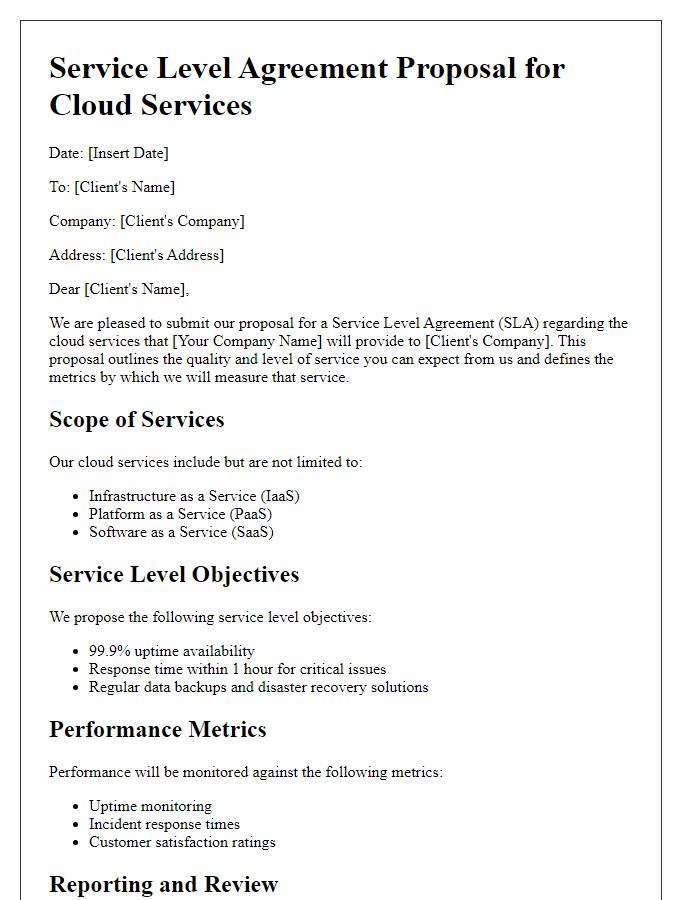Are you looking to establish a solid partnership that enhances service delivery and sets clear expectations? Crafting a service level agreement (SLA) can create a roadmap for success, ensuring that both parties understand their responsibilities and commitments. This agreement not only fosters transparency but also builds trust, helping to avoid misunderstandings down the line. Ready to dive deeper into creating an effective SLA? Keep reading to discover essential tips and templates!

Introduction and Purpose
A Service Level Agreement (SLA) outlines the expected service standards between a service provider and a client. This document serves as a foundational guideline to ensure mutual understanding and accountability for both parties involved. The purpose of this SLA proposal is to establish clear expectations regarding service delivery, performance metrics, and responsibilities. By defining key performance indicators (KPIs) such as uptime percentages (e.g., 99.9% uptime commitment), response times for support requests (e.g., under 2 hours), and resolution times for issues (e.g., within 24 hours), this agreement aims to enhance service quality and customer satisfaction. Additionally, the SLA will cover procedures for monitoring and reporting service performance, thereby facilitating ongoing communication and improvement.
Scope and Objectives
The scope of the proposed Service Level Agreement (SLA) encompasses a wide range of services aimed at ensuring optimal performance and reliability for clients. Key objectives include maintaining system uptime at 99.9% within a defined geographic area, implementing response times for critical incidents within two hours, and ensuring that all routine maintenance tasks are completed within set time frames (usually 24 hours). Additional focus will be placed on proactive monitoring of network performance and user support, with a dedicated help desk operating seven days a week. Specific metrics will be established to evaluate service performance, such as ticket resolution times, customer satisfaction levels, and compliance with predefined service benchmarks. Essential stakeholders, including IT departments and project managers, will engage in regular review meetings to discuss performance, address potential issues, and identify opportunities for continuous improvement.
Service Description
A Service Level Agreement (SLA) proposal outlines the expectations and responsibilities between service providers and clients regarding the delivery of services. This document typically includes detailed descriptions of services offered, including scope and limitations. For example, IT managed services may encompass 24/7 helpdesk support, network management, and cybersecurity measures. Detailed metrics such as response time (e.g., under 30 minutes for critical issues) and uptime commitment (e.g., 99.9% availability per month) are crucial. Additionally, the proposal may specify penalties for breaches, such as service credits for downtime exceeding the agreed-upon limit. Essentials like the point of contact, escalation procedures, and regular review meetings contribute to building a structured communication framework, ensuring both parties align on performance expectations.
Performance Metrics and Monitoring
Performance metrics play a critical role in evaluating the efficiency and effectiveness of service delivery within a Service Level Agreement (SLA) context. Key performance indicators (KPIs) such as response time, typically quantified in hours or minutes, measure how quickly service requests are addressed. Additionally, uptime percentage, frequently targeted at 99.9% in IT service sectors, assesses the reliability of services offered. Monitoring frameworks, often utilizing software tools like Splunk or Nagios, facilitate real-time tracking of these metrics. Regular reviews, conducted monthly or quarterly, ensure alignment with business goals and client satisfaction. Stakeholder engagement during these reviews is vital, providing a platform for feedback and continuous improvement.
Terms and Conditions
A comprehensive service level agreement (SLA) proposal outlines critical terms and conditions related to the provision of services between parties, ensuring clear expectations. Response times for critical incidents typically range from 1 to 4 hours, establishing urgency in resolution processes. Availability requirements often stipulate a minimum uptime percentage, such as 99.9%, illustrating the commitment to service continuity in data centers like Amazon Web Services. Penalty clauses may specify credits, often 10% of monthly fees, applied if service levels fall below agreed thresholds. Confidentiality provisions safeguard sensitive information, aligning with regulations like GDPR in Europe. Reporting metrics detail performance evaluations, typically reviewed quarterly, validating compliance and fostering trust between involved parties.
Letter Template For Service Level Agreement Proposal Samples
Letter template of service level agreement proposal for customer support

Letter template of service level agreement proposal for maintenance services

Letter template of service level agreement proposal for facility management

Letter template of service level agreement proposal for software development

Letter template of service level agreement proposal for logistics services

Letter template of service level agreement proposal for consulting services

Letter template of service level agreement proposal for telecommunications







Comments